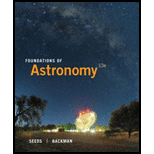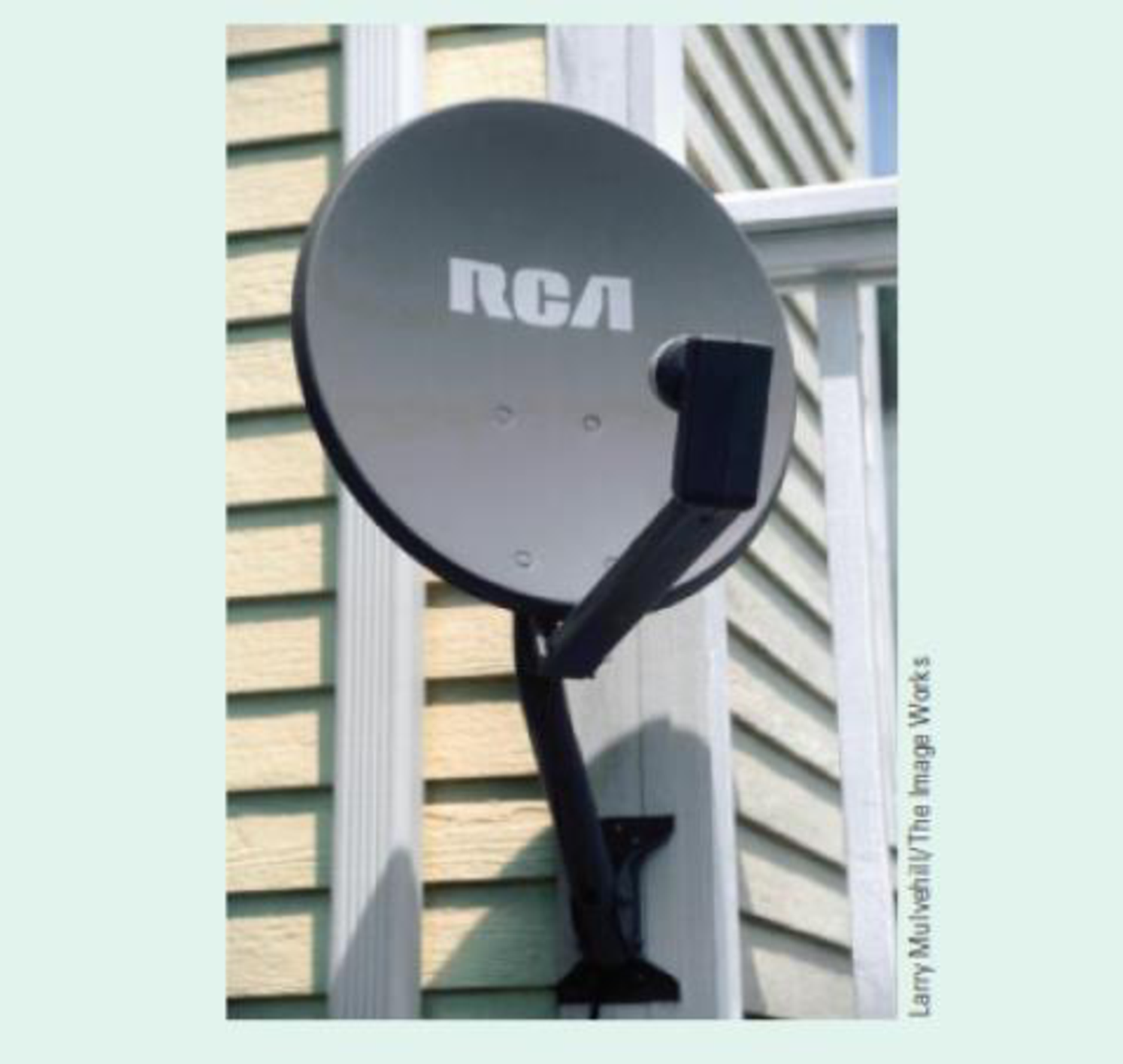
Foundations of Astronomy
13th Edition
ISBN: 9781305079151
Author: Michael A. Seeds, Dana Backman
Publisher: Cengage Learning
expand_more
expand_more
format_list_bulleted
Concept explainers
Textbook Question
Chapter 5, Problem 1LTL
Why can the object shown here be bolted in place and used 24 hours a day without adjustment?

Expert Solution & Answer
Want to see the full answer?
Check out a sample textbook solution
Students have asked these similar questions
What are the expected readings of the ammeter and voltmeter for the circuit in the figure below? (R = 5.60 Ω, ΔV = 6.30 V)
ammeter
I =
simple diagram to illustrate the setup for each law- coulombs law and biot savart law
A circular coil with 100 turns and a radius of 0.05 m is placed in a magnetic field that changes at auniform rate from 0.2 T to 0.8 T in 0.1 seconds. The plane of the coil is perpendicular to the field.• Calculate the induced electric field in the coil.• Calculate the current density in the coil given its conductivity σ.
Chapter 5 Solutions
Foundations of Astronomy
Ch. 5 - According to the Aristotle, if earth and water...Ch. 5 - Today, what do we call the Aristotelean violent...Ch. 5 - Which of Keplers or Newtons laws best describes...Ch. 5 - Why would Aristotles explanation of gravity not...Ch. 5 - According to the principles of Aristotle, what...Ch. 5 - If you drop a feather and a steel hammer at the...Ch. 5 - What is the difference between mass and weight?Ch. 5 - When a person says he gained weight, does he mean...Ch. 5 - An astronaut working in space near the...Ch. 5 - What is the difference between speed and velocity?
Ch. 5 - A car is on a circular off ramp of an interstate...Ch. 5 - How many accelerators does a car have? What are...Ch. 5 - You put your astronomy textbook and your No. 2...Ch. 5 - An astronaut is in space with a baseball and a...Ch. 5 - You are at a red light in your car. The red light...Ch. 5 - You weigh 100 pounds, your friend weighs 200...Ch. 5 - Why did Newton conclude that some force had to...Ch. 5 - Why did Newton conclude that gravity has to be...Ch. 5 - Prob. 19RQCh. 5 - You are sitting next to a person who has twice as...Ch. 5 - You are sitting next to a person who has twice as...Ch. 5 - You are sitting next to a person who has twice as...Ch. 5 - How does the concept of a field explain action at...Ch. 5 - Why cant a spacecraft go beyond Earths gravity?Ch. 5 - Prob. 25RQCh. 5 - Balance a pencil lengthwise on the side of your...Ch. 5 - Prob. 27RQCh. 5 - Why cant you leave Earths gravitational field when...Ch. 5 - According to Keplers first law, planets move in...Ch. 5 - How do planets orbiting the Sun and skaters doing...Ch. 5 - If a planet were to slowly migrate inward toward...Ch. 5 - If you hold this textbook out at shoulder height...Ch. 5 - Today at the beach you see the highest of all high...Ch. 5 - Why is the period of an open orbit undefined?Ch. 5 - In what conditions do Newtons laws of motion and...Ch. 5 - Prob. 36RQCh. 5 - When you ride a fast elevator upward, you feel...Ch. 5 - Prob. 38RQCh. 5 - How is gravity related to acceleration? Are all...Ch. 5 - Near a massive planet, is gravitational...Ch. 5 - Prob. 41RQCh. 5 - How Do We Know? Why is it important that a theory...Ch. 5 - Prob. 1DQCh. 5 - Prob. 2DQCh. 5 - Prob. 3DQCh. 5 - Prob. 4DQCh. 5 - Prob. 5DQCh. 5 - Prob. 6DQCh. 5 - Prob. 7DQCh. 5 - An astronomy textbook is to be dropped from a tall...Ch. 5 - Compared to the strength of Earths gravity at its...Ch. 5 - Compare the force of gravity on a 1 kg mass on the...Ch. 5 - Prob. 4PCh. 5 - The International Space Station is in orbit around...Ch. 5 - If a small lead ball falls from a high tower on...Ch. 5 - What is the circular velocity of an Earth...Ch. 5 - What is the circular velocity of an Earth...Ch. 5 - What is the orbital speed at Earths surface?...Ch. 5 - Prob. 10PCh. 5 - Prob. 11PCh. 5 - Describe the shape of the orbit followed by the...Ch. 5 - Prob. 13PCh. 5 - Prob. 14PCh. 5 - Prob. 15PCh. 5 - Prob. 16PCh. 5 - A moon of Jupiter takes 1.8 days to orbit at a...Ch. 5 - Why can the object shown here be bolted in place...Ch. 5 - What is the flux at position 2 compared to...Ch. 5 - Why is it a little bit misleading to say that this...
Knowledge Booster
Learn more about
Need a deep-dive on the concept behind this application? Look no further. Learn more about this topic, physics and related others by exploring similar questions and additional content below.Similar questions
- An L-C circuit has an inductance of 0.410 H and a capacitance of 0.250 nF . During the current oscillations, the maximum current in the inductor is 1.80 A . What is the maximum energy Emax stored in the capacitor at any time during the current oscillations? How many times per second does the capacitor contain the amount of energy found in part A? Please show all steps.arrow_forwardA long, straight wire carries a current of 10 A along what we’ll define to the be x-axis. A square loopin the x-y plane with side length 0.1 m is placed near the wire such that its closest side is parallel tothe wire and 0.05 m away.• Calculate the magnetic flux through the loop using Ampere’s law.arrow_forwardDescribe the motion of a charged particle entering a uniform magnetic field at an angle to the fieldlines. Include a diagram showing the velocity vector, magnetic field lines, and the path of the particle.arrow_forward
- Discuss the differences between the Biot-Savart law and Coulomb’s law in terms of their applicationsand the physical quantities they describe.arrow_forwardExplain why Ampere’s law can be used to find the magnetic field inside a solenoid but not outside.arrow_forward3. An Atwood machine consists of two masses, mA and m B, which are connected by an inelastic cord of negligible mass that passes over a pulley. If the pulley has radius RO and moment of inertia I about its axle, determine the acceleration of the masses mA and m B, and compare to the situation where the moment of inertia of the pulley is ignored. Ignore friction at the axle O. Use angular momentum and torque in this solutionarrow_forward
- A 0.850-m-long metal bar is pulled to the right at a steady 5.0 m/s perpendicular to a uniform, 0.650-T magnetic field. The bar rides on parallel metal rails connected through a 25-Ω, resistor (Figure 1), so the apparatus makes a complete circuit. Ignore the resistance of the bar and the rails. Please explain how to find the direction of the induced current.arrow_forwardFor each of the actions depicted, determine the direction (right, left, or zero) of the current induced to flow through the resistor in the circuit containing the secondary coil. The coils are wrapped around a plastic core. Immediately after the switch is closed, as shown in the figure, (Figure 1) in which direction does the current flow through the resistor? If the switch is then opened, as shown in the figure, in which direction does the current flow through the resistor? I have the answers to the question, but would like to understand the logic behind the answers. Please show steps.arrow_forwardWhen violet light of wavelength 415 nm falls on a single slit, it creates a central diffraction peak that is 8.60 cm wide on a screen that is 2.80 m away. Part A How wide is the slit? ΟΙ ΑΣΦ ? D= 2.7.10-8 Submit Previous Answers Request Answer × Incorrect; Try Again; 8 attempts remaining marrow_forward
- Two complex values are z1=8 + 8i, z2=15 + 7 i. z1∗ and z2∗ are the complex conjugate values. Any complex value can be expessed in the form of a+bi=reiθ. Find θ for (z1-z∗2)/z1+z2∗. Find r and θ for (z1−z2∗)z1z2∗ Please show all stepsarrow_forwardCalculate the center of mass of the hollow cone shown below. Clearly specify the origin and the coordinate system you are using. Z r Y h Xarrow_forward12. If all three collisions in the figure below are totally inelastic, which will cause more damage? (think about which collision has a larger amount of kinetic energy dissipated/lost to the environment? I m II III A. I B. II C. III m m v brick wall ע ע 0.5v 2v 0.5m D. I and II E. II and III F. I and III G. I, II and III (all of them) 2marrow_forward
arrow_back_ios
SEE MORE QUESTIONS
arrow_forward_ios
Recommended textbooks for you
 Foundations of Astronomy (MindTap Course List)PhysicsISBN:9781337399920Author:Michael A. Seeds, Dana BackmanPublisher:Cengage Learning
Foundations of Astronomy (MindTap Course List)PhysicsISBN:9781337399920Author:Michael A. Seeds, Dana BackmanPublisher:Cengage Learning Stars and Galaxies (MindTap Course List)PhysicsISBN:9781337399944Author:Michael A. SeedsPublisher:Cengage Learning
Stars and Galaxies (MindTap Course List)PhysicsISBN:9781337399944Author:Michael A. SeedsPublisher:Cengage Learning
 Principles of Physics: A Calculus-Based TextPhysicsISBN:9781133104261Author:Raymond A. Serway, John W. JewettPublisher:Cengage Learning
Principles of Physics: A Calculus-Based TextPhysicsISBN:9781133104261Author:Raymond A. Serway, John W. JewettPublisher:Cengage Learning University Physics Volume 1PhysicsISBN:9781938168277Author:William Moebs, Samuel J. Ling, Jeff SannyPublisher:OpenStax - Rice University
University Physics Volume 1PhysicsISBN:9781938168277Author:William Moebs, Samuel J. Ling, Jeff SannyPublisher:OpenStax - Rice University Physics for Scientists and Engineers: Foundations...PhysicsISBN:9781133939146Author:Katz, Debora M.Publisher:Cengage Learning
Physics for Scientists and Engineers: Foundations...PhysicsISBN:9781133939146Author:Katz, Debora M.Publisher:Cengage Learning

Foundations of Astronomy (MindTap Course List)
Physics
ISBN:9781337399920
Author:Michael A. Seeds, Dana Backman
Publisher:Cengage Learning

Stars and Galaxies (MindTap Course List)
Physics
ISBN:9781337399944
Author:Michael A. Seeds
Publisher:Cengage Learning


Principles of Physics: A Calculus-Based Text
Physics
ISBN:9781133104261
Author:Raymond A. Serway, John W. Jewett
Publisher:Cengage Learning

University Physics Volume 1
Physics
ISBN:9781938168277
Author:William Moebs, Samuel J. Ling, Jeff Sanny
Publisher:OpenStax - Rice University

Physics for Scientists and Engineers: Foundations...
Physics
ISBN:9781133939146
Author:Katz, Debora M.
Publisher:Cengage Learning
Rotational Kinematics Physics Problems, Basic Introduction, Equations & Formulas; Author: The Organic Chemistry Tutor;https://www.youtube.com/watch?v=0El-DqrCTZM;License: Standard YouTube License, CC-BY